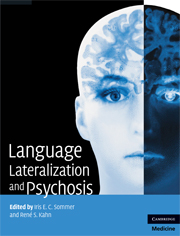
-
Select format
-
- Publisher:
- Cambridge University Press
- Publication date:
- December 2009
- April 2009
- ISBN:
- 9780511576744
- 9780521882842
- Dimensions:
- (246 x 189 mm)
- Weight & Pages:
- 0.64kg, 216 Pages
- Dimensions:
- Weight & Pages:
You may already have access via personal or institutional login
Book description
In 1861 Paul Broca discovered that, in most individuals, the left hemisphere of the brain is dominant for language. Taking language as an example, the first part of this book explains the normal development of bodily asymmetry and lateralization, its association with hand preference, genetic aspects, geographical differences and the influence of gender. The coverage then moves on to review the association between language lateralization and psychosis, describing findings in patients with schizophrenia to suggest the dominant hemisphere may fail to completely inhibit the language areas in the non-dominant half. The language allowed to 'release' from the right hemisphere can lead to psychotic symptoms including auditory verbal hallucinations and formal thought disorder. This book should be read by psychiatrists, neurologists and neuroscientists working in the field of psychosis and other brain scientists interested in laterality.
Reviews
'… intriguing and interesting … a welcome addition to the field. … a fascinating theory … an excellent and absorbing new book on the importance of cerebral laterality to psychotic disorders. Anyone wanting to understand more about how psychosis and the functional organization of the brain interact should read this valuable book.'
Source: Doody's Notes
Contents
Metrics
Altmetric attention score
Full text views
Full text views help Loading metrics...
Loading metrics...
* Views captured on Cambridge Core between #date#. This data will be updated every 24 hours.
Usage data cannot currently be displayed.
Accessibility standard: Unknown
Why this information is here
This section outlines the accessibility features of this content - including support for screen readers, full keyboard navigation and high-contrast display options. This may not be relevant for you.
Accessibility Information
Accessibility compliance for the PDF of this book is currently unknown and may be updated in the future.


